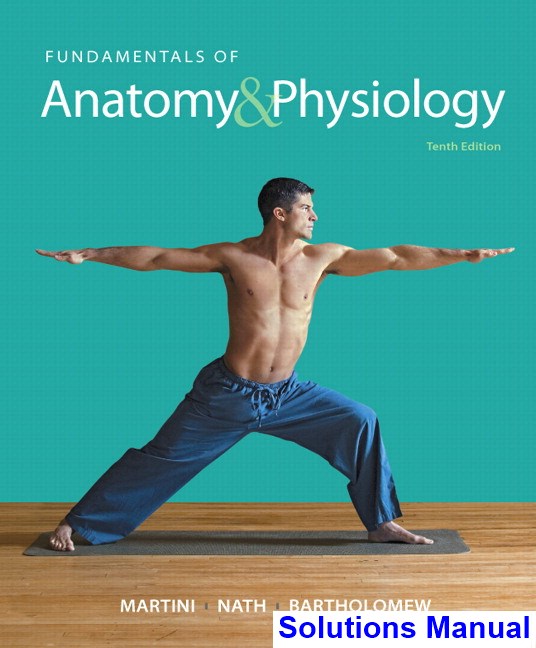Instant download Fundamentals of Anatomy and Physiology 10th Edition Martini Solutions Manual pdf docx epub after payment.
Product details:
- ISBN-10 : 032192861X
- ISBN-13 : 978-0321928610
- Author: Frederic H. Martini;
Table Of Contents:
- UNIT 1 LEVELS OF ORGANIZATION
- 1 An Introduction to Anatomy and Physiology
- An Introduction to Studying the Human Body
- 1-1 Anatomy and physiology directly affect your life
- 1-2 Anatomy is structure, and physiology is function
- 1-3 Anatomy and physiology are closely integrated
- 1-4 Levels of organization progress from molecules to a complete organism
- 1-5 Homeostasis is the state of internal balance
- 1-6 Negative feedback opposes variations from normal, whereas positive feedback exaggerates them
- 1-7 Anatomical terms describe body regions, anatomical positions and directions, and body sections
- 1-8 Body cavities of the trunk protect internal organs and allow them to change shape
- Chapter Review
- Spotlights: Levels of Organization
- Diagnostic Imaging Techniques
- Clinical Case: Using A&P to Save a Life
- Clinical Notes: Autopsies and Cadaver Dissection
- Auscultation
- 2 The Chemical Level of Organization
- An Introduction to the Chemical Level of Organization
- 2-1 Atoms are the basic particles of matter
- 2-2 Chemical bonds are forces formed by atom interactions
- 2-3 Decomposition, synthesis, and exchange reactions important chemical reactions in physiology
- 2-4 Enzymes catalyze specific biochemical reactions lowering the energy needed to start them
- 2-5 Inorganic compounds lack carbon, and organic compounds contain carbon
- 2-6 Physiological systems depend on water
- 2-7 Body fluid pH is vital for homeostasis
- 2-8 Acids, bases, and salts are inorganic compounds with important physiological roles
- 2-9 Carbohydrates contain carbon, hydrogen, and oxygen in a 1:2:1 ratio
- 2-10 Lipids often contain a carbon-to-hydrogen ratio of 1:2
- 2-11 Proteins contain carbon, hydrogen, oxygen, and nitrogen and are formed from amino acids
- 2-12 DNA and RNA are nucleic acids
- 2-13 ATP is a high-energy compound used by cells
- 2-14 Chemicals and their interactions form functional units called cells
- Chapter Review
- Spotlights: Chemical Notation
- Clinical Case: What Is Wrong with My Baby?
- Clinical Notes: Radiation Sickness
- Fatty Acids and Health
- 3 The Cellular Level of Organization
- An Introduction to Cells
- 3-1 The plasma membrane separates the cell from its surrounding environment and performs various fun
- 3-2 Organelles within the cytoplasm perform particular functions
- 3-3 The nucleus contains DNA and enzymes essential for controlling cellular activities
- 3-4 DNA controls protein synthesis, cell structure, and cell function
- 3-5 Diffusion is a passive transport mechanism that assists membrane passage
- 3-6 Carrier-mediated and vesicular transport assist membrane passage
- 3-7 The membrane potential results from the unequal distribution of positive and negative charges ac
- 3-8 Stages of a cell’s life cycle include interphase, mitosis, and cytokinesis
- 3-9 Several growth factors affect the cell life cycle
- 3-10 Tumors and cancers are characterized by abnormal cell growth and division
- 3-11 Differentiation is cellular specialization as a result of gene activation or repression
- Chapter Review
- Spotlights: Anatomy of a Model Cell
- Protein Synthesis, Processing, and Packaging
- Overview of Membrane Transport
- DNA Replication
- Stages of a Cell’s Life Cycle
- Clinical Case: When Your Heart Is in the Wrong Place
- Clinical Notes: Inheritable Mitochondrial Disorders
- DNA Fingerprinting
- Mutations
- Drugs and the Plasma Membrane
- Telomerase, Aging, and Cancer
- Parkinson’s Disease
- 4 The Tissue Level of Organization
- An Introduction to the Tissue Level of Organization
- 4-1 The four tissue types are epithelial, connective, muscle, and neural
- 4-2 Epithelial tissue covers body surfaces, lines cavities and tubular structures, and serves essent
- 4-3 Cell shape and number of layers determine the classification of epithelia
- 4-4 Connective tissue provides a protective structural framework for other tissue types
- 4-5 Cartilage and bone provide a strong supporting framework
- 4-6 Tissue membranes are physical barriers of four types: mucous, serous, cutaneous, and synovial
- 4-7 Connective tissue creates the internal framework of the body
- 4-8 The three types of muscle tissue are skeletal, cardiac, and smooth
- 4-9 Neural tissue responds to stimuli and propagates electrical impulses throughout the body
- 4-10 The response to tissue injury involves inflammation and regeneration
- 4-11 With advancing age, tissue repair declines and cancer rates increase
- Chapter Review
- Spotlights: Inflammation and Regeneration
- Clinical Case: The Rubber Girl
- Clinical Notes: Exfoliative Cytology
- Marfan’s Syndrome
People also search:
fundamentals of anatomy and physiology 10th edition ebook
fundamentals of anatomy and physiology 10th edition
fundamentals of anatomy and physiology eleventh edition
|
fundamentals of anatomy and physiology ebook |






